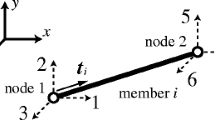Abstract
An approach for designing optimal repetitive structures under arbitrary static loading is presented. It is shown that the analysis of such infinite structures can be reduced to the analysis of the repeating module under transformed loading and boundary conditions. Consequently, both the design parameters and the analysis variables constitute a relatively small set which facilitates the optimization process. The approach hinges on the representative cell method. It is based on formulating the analysis equations and the continuity conditions for a sequence of typical modules. Then, by means of the discrete Fourier transform this problem translates into a boundary value problem of a representative cell in transformed variables, which can be solved by any appropriate analytical or numerical method. The real structural response any-where in the structure is then obtained by the inverse transform. The sensitivities can also be calculated on the basis of the sensitivities of the representative cell. The method is illustrated by the design for minimum compliance with a volume constraint of an infinite plane truss. It is shown that by employing this analysis method within an optimal design scheme one can incorporate a reduced analysis problem in an intrinsically small design space.
Similar content being viewed by others
References
Bendsøe, M.P.; Kikuchi, N. 1988: Generating optimal topologies in structural design using a homogenization method.Comp. Meth. Appl. Mech. Engrg. 71, 197–224
Beyar, R. 1996: The BcStent: An effective answer to coronary lesions.Eur. Hosp. Management J. 3, 64–66
ElHami, A.; Radi, B. 1996: Some decomposition methods in the analysis of repetitive structures.Comp. Struct. 58, 973–980
Fuchs, M.B.; Paley, M.; Miroshnik, E. 1999: The Aboudi micro-mechanical method for topology design of structures.Comp. Struct. (to be published)
Li, D.; Benaroya, H. 1992: Dynamics of periodic and near-periodic structures.Appl. Mech. Rev. 45, 447–459
Mead, D.J. 1970: Free wave propagation in periodically supported infinite trusses.J. Sound Vib. 11, 181–197
Meirovitch, L.; Engels, R.C. 1977: Response of periodic structures by the Z-transform method.AIAA J. 15, 167–174
Noor, A.K.; Andersen, C.M. 1979: Analysis of beam-like lattice trusses.Comp. Meth. Appl. Mech. Engrg. 20, 53–70
Nuller, B.; Ryvkin, M. 1980: On boundary value problems for elastic domains of a periodic structure deformed by arbitrary loads. In:Proc. State Hydraulic Institute 136, 49–55. Leningrad: Energia (in Russian)
Renton, J.D. 1996: Generalized beam theory and modular structures.Int. J. Solids Struct. 33, 1425–1438
Rozvany, G.I.N.; Hampson, A.J.K. 1962: Multistorey frame analysis for vertical loading.J. Amer. Conc. Inst. 59, 959–966
Ryvkin, M.; Nuller, B. 1997: Solution of quasi-periodic fracture problems by the representative cell method.Comp. Mech. 20, 145–149
Williams, F.W.; Kennedy, D.; Whu, G.F.; Zhou, J.Q. 1996: Exact calculation of natural frequencies of repetitive structures.Struct. Eng. & Mech. 4, 553–568
Author information
Authors and Affiliations
Rights and permissions
About this article
Cite this article
Ryvkin, M., Fuchs, M.B. & Nuller, B. Optimal design of infinite repetitive structures. Structural Optimization 18, 202–209 (1999). https://doi.org/10.1007/BF01195995
Received:
Issue Date:
DOI: https://doi.org/10.1007/BF01195995




